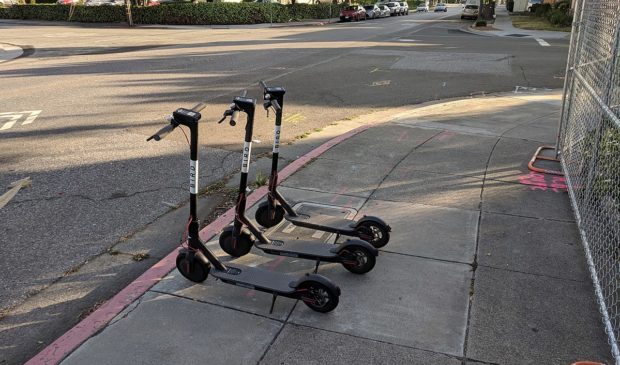Scooters: Committee calls for clear rules
Friday, December 7, 2018 by
Ryan Thornton The number of dockless scooter operators wanting a share of the Austin market continues to rise. This week, Austin welcomed the latest entrant, Lyft, with permits for 1,500 authorized units, pushing the total number of authorized scooters (not the number of actual scooters) in the city to 10,521. The figure is drawing a number of concerns from citizens and their representatives, such as how to regulate so many scooters and whether Austin will let the number of scooters grow forever.
The city, however, is not letting scooter operators make the rules themselves. When Lime and Bird dropped a fleet of scooters downtown in April, the city didn’t ban them entirely like a number of other cities have done. Instead, the Transportation Department began work on a set of rules for dockless mobility operators and users that is still being worked out. During a Mobility Committee meeting Thursday afternoon, questions raised by the committee were similar to those that have been at the forefront of the scooter debate since it began in late spring. They included concerns about incorrect and dangerous use, where scooters belong and where they don’t, who can be held accountable in the case of accidents, and how disturbing some people find scooters, whether parked or in motion.
On the question of danger, Transportation Dept. director Robert Spillar said Austin Public Health in partnership with ATD has invited the Centers for Disease Control to study all scooter-related accidents in Austin. Spillar said the study will begin soon and will address common variables involved in scooter accidents in order to better understand how to prevent them.
One of the big moves the city has made to prevent a number of potential issues was to create a zone, called the downtown Austin project coordination zone (DAPCZ), where the number of authorized dockless scooters from any single operator is limited to 500. The restriction keeps companies from dumping their entire fleets downtown where the most money is to be made, and makes sure the scooters serve people in the less-walkable areas around the city core where personal vehicles are still a necessity for many.
Lime is currently in the middle of a 30-day, 1,000-unit suspension due to several violations of the 500-unit limit in the downtown zone, which the company claims was the result of a technical error. Sam Sadle, Lime’s director of government relations, attended the Thursday meeting and said the company respects the geography-based restriction. “We’re very proud of the fact that on a daily basis we deploy scooters south of Ben White, in northeast Austin, and in Rundberg and Braker Lane areas,” Sadle said. “We really see ourselves as a solution, as part of the solution for mobility across the city of Austin.”
While the committee didn’t question the intentions of Lime or other operators during the meeting, several Council members raised the issue of legal responsibility and liability when accidents inevitably occur. Council Member Alison Alter of District 10 spoke about the need for the city to protect students at the Texas School for the Blind and Visually Impaired who use the area surrounding their campus to practice navigating city streets. In taking such measures, Alter said the city would also be better protected. “There’s a range of liability issues that we need to address moving forward … because otherwise it’s going to be the city that gets sued here,” said Alter.
Spillar said the intent of the department is to promote the responsibility of the individual user. Directing attention away from both the city and the scooter operators, Spillar said, “If a user uses one of these devices and hits somebody, we need to be able to hold that user accountable.”
The trouble with placing responsibility on the user right now is a lack of agreement and understanding from both government and the public regarding the rules of scooter use. Mayor Pro Tem Kathie Tovo said the city wasn’t being firm enough with its language and allowing users too much room to interpret the rules. Specifically concerning scooters on sidewalks, Tovo said the requirement to yield to pedestrians was too ambiguous. Tovo said ideally, riders would be required to dismount in the presence of a high density of pedestrians.
The committee also questioned the purpose and merits of the upcoming pilot program that will allow scooters on a number of trails in town. Council Member Jimmy Flannigan said the pilot doesn’t seem to be solving any particular issue while raising a lot of concern from the community at the same time. Alter stated her intent to create a resolution that will exclude Shoal Creek from the list of trails permitting scooters due to the trail’s insufficient width. “I’m open to excluding other trails, but the reasons that I’m focusing in on Shoal Creek are technical in nature,” she said.
The Transportation Department anticipates clarifying all of these questions and more in an ordinance that is expected to take effect at the end of February 2019.
Photo by Grendelkhan [CC BY-SA 4.0], from Wikimedia Commons.
The Austin Monitor’s work is made possible by donations from the community. Though our reporting covers donors from time to time, we are careful to keep business and editorial efforts separate while maintaining transparency. A complete list of donors is available here, and our code of ethics is explained here.
You're a community leader
And we’re honored you look to us for serious, in-depth news. You know a strong community needs local and dedicated watchdog reporting. We’re here for you and that won’t change. Now will you take the powerful next step and support our nonprofit news organization?



